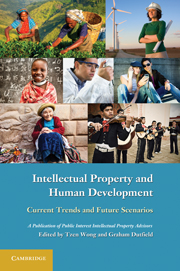Book contents
- Frontmatter
- Contents
- Boxes
- Contributors
- Foreword
- Preface
- Acknowledgements
- Acronyms and abbreviations
- Overview
- 1 Intellectual property through the lens of human development
- 2 Intellectual property and medicine: Towards global health equity
- 3 Food security and intellectual property rights: Finding the linkages
- 4 Trends and scenarios in the legal protection of traditional knowledge
- 5 Traditional cultural expressions: Preservation and innovation
- 6 Copyright and capability for education: An approach ‘from below’
- 7 Knowledge and education: Pro-access implications of new technologies
- 8 Cultural diversity and the arts: Contemporary challenges for copyright law
- 9 Scenario planning on the future of intellectual property: Literature review and implications for human development
- Appendix A Capability, opulence and utility1
- Appendix B Exploring alternative, collaborative models of innovation for medicines and vaccines1
- Appendix C Strategies and laws to promote traditional medicinal knowledge1
- Appendix D Educational use exceptions to copyright: A comparison among selected jurisdictions1
- Appendix E Copyright and contemporary art: A case study
- Index
Appendix B - Exploring alternative, collaborative models of innovation for medicines and vaccines1
Published online by Cambridge University Press: 05 June 2012
- Frontmatter
- Contents
- Boxes
- Contributors
- Foreword
- Preface
- Acknowledgements
- Acronyms and abbreviations
- Overview
- 1 Intellectual property through the lens of human development
- 2 Intellectual property and medicine: Towards global health equity
- 3 Food security and intellectual property rights: Finding the linkages
- 4 Trends and scenarios in the legal protection of traditional knowledge
- 5 Traditional cultural expressions: Preservation and innovation
- 6 Copyright and capability for education: An approach ‘from below’
- 7 Knowledge and education: Pro-access implications of new technologies
- 8 Cultural diversity and the arts: Contemporary challenges for copyright law
- 9 Scenario planning on the future of intellectual property: Literature review and implications for human development
- Appendix A Capability, opulence and utility1
- Appendix B Exploring alternative, collaborative models of innovation for medicines and vaccines1
- Appendix C Strategies and laws to promote traditional medicinal knowledge1
- Appendix D Educational use exceptions to copyright: A comparison among selected jurisdictions1
- Appendix E Copyright and contemporary art: A case study
- Index
Summary
There has been increasing debate over the appropriateness of the intellectual property (IP) system for the promotion of pharmaceutical innovation and access to medicines. Some have argued that the reason poor countries have difficulty accessing medicines is not related to the IP system, but due to deficient health infrastructures and precarious local sanitation systems in the developing world (International Federation of Pharmaceuticals Manufacturers & Associations [IFPMA] 2004, p. 49). Others have qualified that a differentiation in local infrastructures does not detract from the fact that global structures, including the international IP system, actively shape those local variants and inequities. Among those who think that the IP system is flawed, whether in its design or implementation, there are increasing discussions about finding new and better models of innovation and medical progress. In a recent report by the International Expert Group on Biotechnology, Innovation and Intellectual Property entitled Toward a New Era of Intellectual Property: From Confrontation to Negotiation (‘IEGBIIP Report 2008’), a distinction is made between so-called ‘Old IP’ and an evolving ‘New IP’ era. The former refers to the way the IP system has been interpreted traditionally, mainly using principles of competition and profit-making as the basis for innovation. The core finding of the report is:
[P]olicy-makers and business leaders must give shape to a new era of intellectual property (IP) to stimulate innovation and broaden access to discoveries. The current system, ‘Old IP’, rests on the belief that if some IP is good, more must be better. But such thinking has proved counterproductive to industry, which in health fields has seen declining levels of innovation despite increasing stakes in IP. The era of Old IP has also proved counterproductive to the world's poor who await advances in health and agriculture long available to the global elite.
According to the IEGBIIP Report, the actors involved in research and development (R&D) need a shift in paradigm towards a ‘New IP’ model based on the concept of sharing knowledge rather than hoarding knowledge – a model where IP is viewed as a ‘servant to … values such as equity and fairness’ (ibid., p. 14). This emphasis that IP should be evaluated as a means towards attaining social justice and improving human well-being, rather than simply as an end in itself, echoes the human development paradigm discussed in Chapter 1 of this book. The ‘New IP’ model also reflects cultural factors in the innovation process, along with collective processes as a route towards equitable reforms. Innovation is seen as a social and communal phenomenon, a product of actors collaborating rather than working in isolation. The IEGBIIP Report offers numerous examples of this collaborative approach, including many public-private partnerships (PPPs). From the Public Interest Intellectual Property Advisors (PIIPA) literature review for this book, other examples of alternative, collaborative models for pharmaceutical innovation have been identified. Some models are briefly described here along with challenges or obstacles. Most of the models seek to direct funding to treatments for diseases where traditional market incentives have been insufficient, or explore different means of financing and rewarding research efforts.
- Type
- Chapter
- Information
- Intellectual Property and Human DevelopmentCurrent Trends and Future Scenarios, pp. 369 - 375Publisher: Cambridge University PressPrint publication year: 2010



